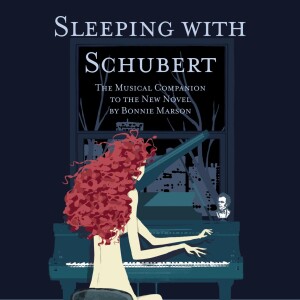 This collection is a companion piece to a book of the same title. It’s a lightweight book about a young woman who suddenly finds the ghost of Schubert somehow sharing her body. This CD, which touches on a smattering of the styles in which Franz Schubert composed music, is a fine introduction to his work — although as I say in the book review, it doesn’t really represent much of the music touched on in Bonnie Marson’s novel.
This collection is a companion piece to a book of the same title. It’s a lightweight book about a young woman who suddenly finds the ghost of Schubert somehow sharing her body. This CD, which touches on a smattering of the styles in which Franz Schubert composed music, is a fine introduction to his work — although as I say in the book review, it doesn’t really represent much of the music touched on in Bonnie Marson’s novel.
Schubert was born in 1797 and died in 1828 at the age of 31. He was roughly a contemporary of Beethoven’s, born nearly 30 years later but dying only one year after Ludwig’s passing. Schubert’s music clearly was influenced by Beethoven’s, particularly in its dynamics, phrasing, the romance of his melodies — just generally the overall feel of it, minus the gravitas. So, if you like Beethoven but haven’t given Schubert a spin, do; you might like it too.
Listening to this collection, you might find out that you know more of Schubert’s music than you think. It opens with one of his two best-known works, the song “Ave Maria.” This recording by the Ensemble Wien-Berlin is a particularly schmaltzy version, to my ears anyway, with the melody carried by oboe and the rest of the woodwinds twittering behind it like something scored for a Looney Toons production.
Schubert’s second best-known work is the so-called “Unfinished” Symphony, his No. 8. The melody from this section, the Allegro moderato, will be immediately familiar to anyone who has listened to a radio or watched TV or movies in the past few decades. The Classical Band, conducted by Bruno Weil, does a superb job with both this piece and the final track, the Finale from “The Great” Symphony No. 9, with its Sousa-like brass passages — very rousing.
The Viennese composer was quite fond of lieder, little German art songs, and there are two very nice examples here: “Gretchen am Spinnrade,” with the crystalline soprano voice of Kiri Te Kanawa, Richard Amner on piano; and “Serenade,” by the baritone Bo Skovhus, Helmut Deutsch on piano. From the descriptions of his lieder in the book, I had expected something syrupy or drippy, but both these pieces are really quite nice.
In keeping with the piano-dominated story line from the companion book, the CD has several piano pieces. Best of the lot is the Scherzo from “The Trout” Quintet for piano and strings. Another of Schubert’s better-known works, this piece has a bounding, onomotopoeic melody that’s really quite enchanting with its complex counterpoint among the various instruments. Also featured are a couple of piano duo works played by Yaara Tal and Andreas Groethuysen, the Andante from the “Grand Duo” Sonata and the haunting “Fantasie in F Minor.” And a real workout for solo piano is the “Impromptu in E-flat Major,” with Andreas Haefliger at the keyboard. This piece has a split personality, with a series of stately half-note chords played by the left hand, and sprightly 32nd-note runs by the right — but it never feels like a Chopin Etude. Finally, the Artis Quartett turns in a lovely performance on the supremely romantic Scherzo from the “Death and the Maiden” String Quartet.
As I said, this disc is a decent overview from the varied styles in which Schubert composed. If you’re looking for an introduction to his works, it’s not a bad place to start.
(Sony Classical, 2004)
